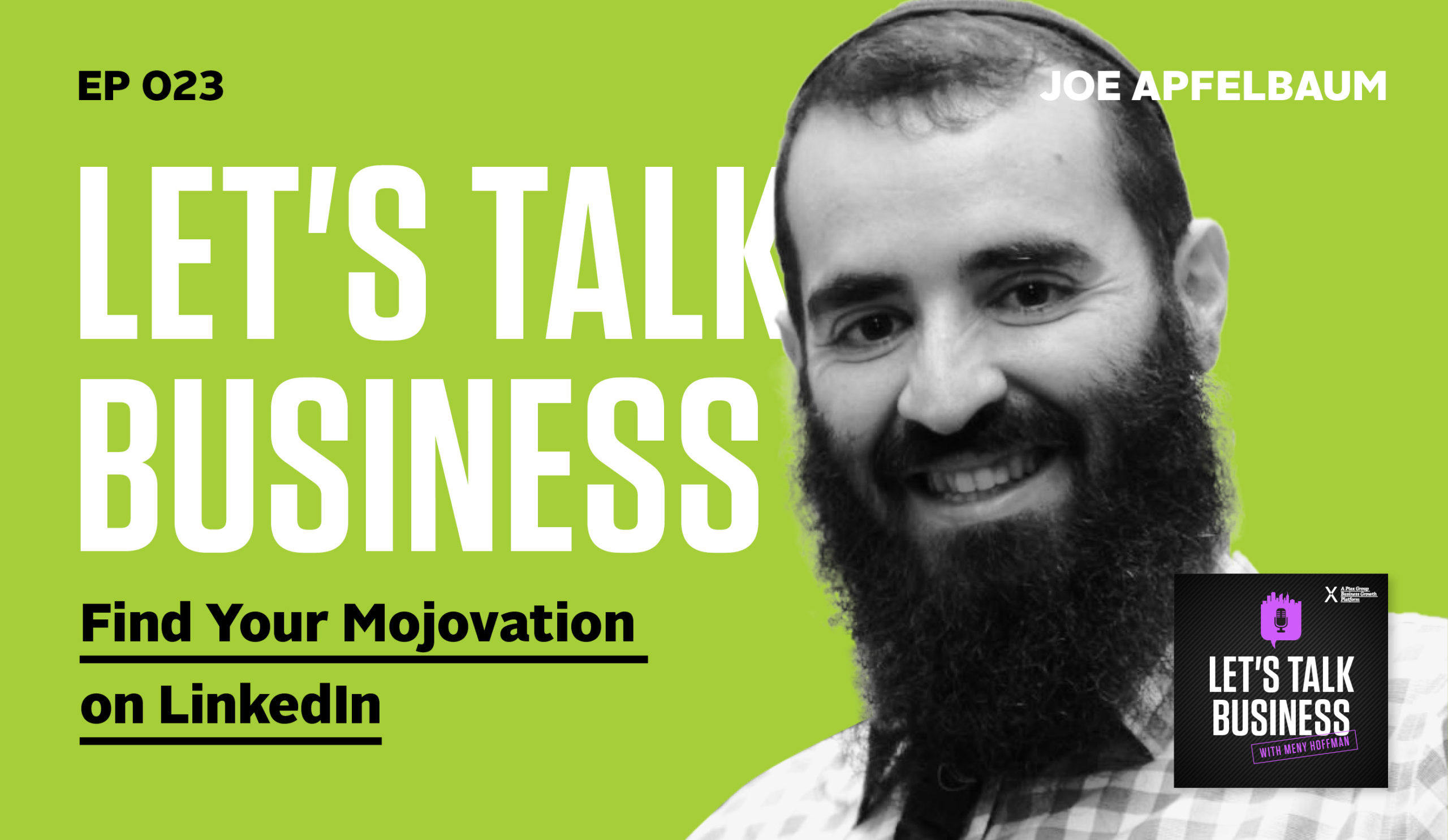Philanthropic advisor, Kristen-Putnam Walkerly joins Meny Hoffman to discuss new trends in philanthropy and what nonprofits can do to stay relevant and funded.
Are you looking for a fresh angle on how to build your business in 2021?
If yes, then I’m thrilled to share my interview with Kristen Putnam-Walkerly. Kris is a trusted advisor to the world’s leading ultra-high net worth donors and foundations, charitable Fortune 500 companies, celebrity activists and wealth advisors for over 20 years. As a philanthropy advisor, speaker, and award-winning author, she’s helped hundreds of philanthropists strategically allocate over half a billion dollars in grants and gifts.
In our interview, Kristen explains why many nonprofits have to pivot to find new sources of support in the wake of the pandemic and what we can learn from this. She explains that nonprofits must organize themselves for growth just like any small business in order to capitalize on emerging trends in the world of philanthropy. Pay special attention to the way Kristen shares some common mistakes that people make when donating funds and practical tips for organizations that want to position themselves to attract more funding for their cause.
There is so much amazing advice packed into this interview. Listen and enjoy
Listen to the podcast here:
Download the audio file here.
Trends In Philanthropy: Placing Money Strategically to Better the World—with Kristen-Putnam Walkerly
Kris, thank you for joining me on the show.
Thank you for having me.
Our readers are used to reading leadership conversations, culture conversations, financial conversations, how to have a healthier business, and stuff like that. Today, we’re doing it a little differently. The reason why we connect it is you teach all about philanthropy and about giving on both sides. On the side of managing, you manage for philanthropists for many years, but also the part of the foundations/organizations, and everything we want to discuss. Before we start, tell our readers a little bit about yourself and your history.
I’m the President of Putnam Consulting Group and I advise primarily philanthropists. This means ultra-high net worth donors, leaders of grant-making foundations, corporate giving programs, family foundations, corporate foundations, and community foundations all over the world. I help them in three areas. One is to increase the clarity of their work and what they’re trying to accomplish with their giving. The second is to increase the impact of their giving, so that at the end of the day, you want to know that you’re making a difference. The third is to increase the joy that they experience in giving so that they feel fulfilled in their philanthropic journey.
I want to make sure that we cover both sides of the coin which is a little bit of the understanding of what goes into a decision-making process of somebody, their family as well, that has a foundation that has the funds to contribute to society. We also want to discuss a little bit about those nonprofits. There’s a saying that I use a lot, I heard it once from an executive director of a large nonprofit, and he told me, “Meny, the only difference between a nonprofit and a for-profit is the tax code, how the IRS writes the tax return.”
Other than that, it’s run as a business, which means it needs to have the full division of the organization, the reach, who they’re going after, and so on and so forth. We’ll get into it, but let’s first speak about the donors and the foundations. What could you share from your past experience? What goes into such a decision-making process if somebody decides to write that big check or give that commitment of a large donation?
[bctt tweet=”If you want to give money away for a cause, you want to first think about what is meaningful to you, where you want to make a difference.” username=””]
What should go into it is attaining that clarity as to what you want to accomplish and what causes are meaningful to you, and the kind of impact you want to have. It doesn’t matter if you’re a billionaire or you have $1,000 to give away. You want to first think about what is meaningful to you, what’s happening in the world around you, or in your community where you want to make a difference. That could be because you have a personal experience with heart disease or mental health in your family or something, and you want to make an impact. It could be because of the things you learn about in the world around us like a global pandemic, for example. You want to create change, and then you want to think about, “What’s the best way that I can do that?”
First, focus on, “What kind of impact do I want to have? What issues are important to me?” You want to think about, “How do I go about doing that?” Certainly, you’re giving money away, but you want to think about to whom or to what kinds of organizations? How do you identify the organizations that you think are doing the best work or having the greatest impact? Even you want to think about, “What’s the right intervention to create that change.” For example, pick any issue and tell me what’s a passion or a cause that you care about.
Let’s say teens at risk.
Perfect. There are all kinds of ways that you could help teens at risk. Quite frankly, you could start by providing them with a pre-school, a high-quality early childhood education. Make sure that they’re prepared for kindergarten, can succeed, can read by third grade, and have the supports they need so that they’re not at risk as teenagers. Let’s say they’re teenagers now. There are lots of ways you could approach that.
You could think about it from the education system. What’s the likelihood that they’re getting high-quality education? Are they on track to graduate from high school? Do they need mentors? Is violence an issue and how you could focus on violence prevention? The point I’m trying to make is there are lots of hows in terms of how to do something or how to support something. You want to think about, what are your options? What are some of the best practices and what are the organizations who are doing meaningful work so that you can support them?
Let me ask you a follow-up question to that. We’re going to get through the organization side in a moment, but we constantly see somehow, organizations are able to convince a foundation or somebody that’s looking to give. We see now philanthropy in the world is taking a huge shift as far as the billionaire’s giving away huge chunks of their money. What are you seeing as trends? Are you seeing trends of that money going towards prevention, going towards fixing a problem, going to redevelopment? What are you seeing from your experience where the trends are, where is this money going in general?
I’d say there are four main trends. One is the response to the pandemic. There has been tremendous growth in giving related to supporting food banks and making sure there’s ample PPE, and helping students and their families when they’re suddenly forced to be educated from home with parents who are working or attempting to work. There are lots of response in regards to the pandemic. One of the ways that this is happening is through what’s called “rapid response” funds. In every community across the United States and increasingly around the world, there are groups of donors, companies, businesses and foundations coming together to create pooled funds so that anyone can donate to this fund. And a group of seasoned professional philanthropists are making decisions.
There’s a single application process that nonprofits can apply for funding. There’s more of a coordinated way to disperse the funding across a community to make sure that all different kinds of needs are met. In a crisis, people tend to respond to the immediate gut reaction or the most obvious need, which in often cases might be like a food pantry, a food bank. That’s great because that’s a need, but you don’t want all the donors giving to a food bank and then no one remembering, “We need to make sure that kids have access to high-quality education. What about preschool? What about people who are in domestic violence shelters that now can’t stay there anymore safely and have no place to go?” You want to make sure that there’s a coordinated response to a crisis and the community, and these planned pooled funds can be helpful.

A huge trend is in funding in response to the police brutality and institutional racism that’s been going on for hundreds of years. We’ve seen what has risen to many people’s attention after the murder of George Floyd in May 2020, and the racial reckoning that’s been happening in this country since. There has been tremendous growth in giving around racial equity and racial justice in particular. Between the beginning of June 2020 and sometime in September 2020, there was about $6 billion raised by foundations in the US to address racial equity. This is more than the past eleven years combined, which is good. It’s important. Hopefully, that trend will continue.
A third trend, which is interesting, has been the extent to which donors, foundations, and companies have removed restrictions on nonprofits to get the money to them more quickly and provide more flexible dollars to nonprofits, especially during this pandemic. What typically happens is a donor allocates a grant and then puts lots of restrictions on it, “You can use it for this program, but not for that program. Only 5% of the grant can be used for overhead. I’m only going to give it to you in one-year increments. You have to submit all kinds of lengthy reports.” There are all these restrictions and expectations that make it hard for nonprofits to do their work because it’s hard to do it in a piecemeal fashion. It’s hard to do it when you’re not allowed to invest in yourself.
What donors have done, and many of them have done instead is to say to nonprofits, “We need you to respond to this crisis. Here’s $10,000. You don’t even have to apply for it. Just show up. There’s a check waiting for you at the office. We trust you to use it however you need to.” They’re removing restrictions. They’re saying to the nonprofit, “I know you wanted to support. You have a program of early childhood education and we were funding you to fund the teachers in the classroom. Now that that’s not physically possible, you can use the money for however you want so you can navigate through this crisis. We trust you and your leadership.” Many are also saying, “Instead of writing a report at the end of all this, we’ll call you when the crisis is over. We’ll take the notes and submit the report for you.” There’s been a lot of flexibility that funders are showing. Hopefully, that will stick once this crisis is over.
I want to ask you a follow-up question. This is something that we’ve seen and let’s hope we should not see more of those things where there is an immediate need. You see it after the hurricanes. You see it after any type of natural disaster as well. All those funds pop up and then automatically to the other side, all these causes or organizations pop-up. The question is, how do we make sure that if somebody wants to give that they’re not just giving by emotion based on what happened? Even based on what’s happening, that they are giving it in the right form and also for the right places within this issue? What are any mistakes you see philanthropists do by giving during a crisis, and not maximizing their donation dollars?
There are lots of mistakes. I wrote a guide that might be useful for your audience. It’s called Six Mistakes Philanthropists Make During A Crisis (And What They Can Do Instead), and you can download it at SixCrisisMistakes.com.
What would be the 1 or 2 from those six that you feel that it’s important to share now?
One is the same point that you mentioned, which is there are people who responded to an immediate need. There’s a wildfire, a hurricane, an earthquake, a pandemic or whatever. Your gut is to offer immediate response funding, which is important because people need shelter. They need safety and food, but there are generally four phases to any crisis. It’s important to ensure that there’s a philanthropic response to all four phases. You think about not just the immediate response, but also the recovery phase, the rebuilding phase, and the resilience phase.
Let’s take the pandemic. There’s an immediate need for kids who don’t have access to the internet or access to a device with which to connect to their teachers in their classroom remotely. That’s an immediate need. You might want to get tablets and broadband available to families immediately. But there’s a larger issue going on, which is the fact that we have this huge digital divide in this country and other places around the world where kids don’t have access to technology. That puts them further behind from their peers in terms of their learning, proficiency and skills development when they become adults and are in the workforce. This is especially true in rural areas, as well as in many urban areas. That’s a larger systemic issue that needs to be addressed. It’s not a quick fix, but it’s something that needs to be tackled. And then we need to build in resiliency so that we are able as a community, as a city, as a country to respond quickly to crises. That goes for business leaders, so we have those systems in place as well.
[bctt tweet=”Disruption is the status quo, but you can build in real time and adapt to the changes.” username=””]
In general, about philanthropy based on you’ve been in this for quite some time now, there was always philanthropists going back to decades of people coming in, giving, changing, and making a difference. Have you seen trends as far as more of those are happening, or less of that are happening? We see a lot more people with money and large corporations that give away parts of their profits to nonprofits. What have you seen as far as trends, as far as where this is going?
I’d see a few different trends. One is that there’s a growth of different kinds of giving vehicles. You can give by writing a check or making an online donation. Also, you can give by starting a foundation, which is increasingly easier to do in the sense that there are lots of organizations, financial wealth advisors, consulting firms even that are able to help you to start creating a foundation and run it. There are also donor-advised funds. You think of them as a charitable checking account. You can open a donor-advised fund. Now, at least you can get an immediate tax deduction by allocating $5,000 or $500,000, whatever the amount is, into this fund.
You can use that account to support different nonprofit organizations. The benefit is that there is another entity, another organization that’s managing it for you. This could be like your local community foundation. You can open up your donor-advised fund through a community foundation. The benefit of that is that’s a local organization that knows the community well, knows the nonprofits, and can help you figure out which are the right organizations to support in your area. You can also open it through a larger commercial fund like Fidelity Charitable or Schwab Charitable or Vanguard Charitable.
What they’ll do is they’ll help you with the transaction. To some degree, they can help you figure out which organizations to support, but they also manage all the taxes. They manage the account, issue the payments, and handle all the paperwork. It’s an option that allows donors to make it easier to give in many ways. There’s been a huge increase in donor-advised fund, people who are opening those accounts, and the funding that’s being issued, especially in 2020 during the pandemic.
One of the things that I’ve seen tremendously on the local level is crowdfunding, which is collecting money from smaller donors, but a ton of donors at a time.
The use of technology has been phenomenal in terms of increasing the ability of people to identify organizations to support them through tactics like crowdfunding. Another huge growth has been GivingTuesday, which I’m sure many of your readers have heard of, which is an annual day. We had it in early December 2020. This is a global phenomenon. It’s a nonprofit organization that’s running it. It’s a day to encourage giving. They have a record-breaking year. On top of that, they created an extra giving day earlier in the pandemic to help people find ways to give, and help nonprofits to receive additional funding. That’s been another growing trend.
Let’s speak about nonprofits. We at Ptex Group work with a lot of nonprofits, especially on a local level, but some of them are national or even international organizations, and a lot of organizations in Israel as well. I want to speak about everybody who wants to increase their fundraising. Not only increase the fundraising but try to connect to those larger donors, and see how they could get money from those larger donors. Let’s start where you want to take this as far as, what do you see? How does a nonprofit need to be positioned? What level of clarity do they need to have in order to gain the trust and the dollars from those foundations or philanthropists in general?
Nonprofits need three things. One is a strategy. Two is sufficient capacity and infrastructure as an organization. The third is an abundance mindset. Let me talk about each of those. I also talk about them in my latest book, which is called Delusional Altruism. If your readers want to learn more, they can learn more in the book. First of all, having clarity on your strategy is super important because it allows you to align your entire organization, your nonprofit, your business, your foundation, whatever, toward what’s most important. It gives you a framework for making decisions that are congruent with where you want your nonprofit or your organization to go. Too often we think strategic planning is this lengthy cumbersome exercise, data gathering, writing of documents, and theories of change.

Especially now, we don’t have the luxury of waiting a year to create a five-year plan because by the time the year’s up, the world will have changed twice. I advise people to quickly create a strategy based on the information they have available to begin implementing it immediately and use it for as long as it makes sense, then to adapt and change it quickly as conditions change around them. I also wrote this guide that your readers might be interested in. It’s called 8 Things Every Philanthropist Can Do To Change The World Even When The World Keeps Changing. They can download it at EightThings.org. It’s applicable not only to philanthropists, but to nonprofits and businesses as well.
It provides eight easy steps you can take to quickly create a plan that you can count on, even when it feels like the conditions all around us keep changing, so that you have clarity as an organization to where you’re headed. You can align your team, your people, and your systems toward what’s most important or your top priorities for achieving your strategy in the next twelve months. You can do it with the confidence of knowing that you can change course quickly because things are going to change. The world is always uncertain. Disruption is the status quo, but you can build in time in your calendar to check in on your progress and see what’s changed and, do you need to adapt or abandoned anything or add anything? Having that strategy is important not only to guide your own work, but as a nonprofit to convey to your funders what you’re trying to do, and how they can help you. When your funders know that you’re clear on where you’re headed, and you have a plan for getting there, it’s much easier for them to understand where they fit and how they can help you to achieve that.
The second thing I mentioned is building your capacity and your organizational infrastructure. The nonprofits that are succeeding now, that entered this crisis, and were able to keep going, to pivot, to persevere in many cases are either surviving, which is a big accomplishment. Keeping the doors open is a big accomplishment, but many are thriving and innovating. It’s those who had strong organizations going into the crisis. Meaning, they had a strategy, they had good financial management systems. Think of how important it was for a business or for a nonprofit to be able to quickly get PPP loans or EIDL or Federal loans. You had to have your financial management in order. You had to be able to quickly access your financial documents. You had to know your cashflow. If you didn’t have all that at the ready, then you were scrambling to figure it out, and that costs you a lot of critical time, delays and stress on your team and yourself.
It’s having that infrastructure, having a good fund development apparatus in place, and a great way to communicate. Communication and investments in technology are important these days. The ability to evaluate yourself so that you can know what’s working and what’s not working in your services so that you can make changes and improvements. All of these things are important. To the point that you made earlier, they are all as important for a nonprofit as they are for a business. Too often, nonprofits don’t believe that they need to invest in themselves. Funders don’t believe that those investments are important.
There’s this misguided scarcity mindset in the nonprofit and philanthropic sector that I also write about in the book, Delusional Altruism. It’s this misguided belief that nonprofits should somehow maintain a spartan operation, that all of the resources need to go to “help people.” Overhead is bad, paying your staff a decent salary is bad, investing in yourself is bad. It’s all bad. It makes no sense because if you have a cause that you believe in like teens at risk, and you find an organization that’s doing great work, mentoring or job training for teens or whatever it is, don’t you want them to be as successful as possible? Don’t you want them to have top talent, a great strategy, good financial management, a great board of directors, a good way to communicate and do outreach? Of course, you do but all of that takes investment. It’s the same as a business. You and I understand the importance of marketing and investments in our teams, our professional development, good bookkeeping and accounting, technology upgrades, whatever it might be. We have to invest in ourselves in order to be successful, and nonprofits need to do that too.
The third point is the notion of this abundance mindset. Part of it is this belief that nonprofits need to invest in themselves. Even funders and philanthropists need to embrace this abundance mindset of the confidence that even you as a funder need to invest in yourself, your own learning, your own relationship development. The abundance mindset for a nonprofit also is recognizing that you’re a peer of your donor. Your donor might have a million or a billion dollars, but not to let that intimidate you because you as a nonprofit leader have assets, talents, knowledge, experience that maybe nobody else has, and your donor probably doesn’t have. They’re relying on you to meet their mission.
A company, a foundation, a donor might have a mission to reduce poverty in their community or help kids get a high-quality education, but they’re not the ones teaching the kids. They’re not the ones helping the kids get into college. They’re funding the nonprofit to do that. They’re funding nonprofits to help them meet their mission. There you are as the solution to their problem. The solution to meeting their mission. You have to have this abundance mindset of confidence and recognition of the value that you bring because otherwise, it feels like you’re asking for a handout and you’re not. Nonprofits are providing tremendous value to our communities, to our country, and to the world. Having that abundance mindset is important for all nonprofits to realize.
Let’s say an organization that they know the cause, they’re passionate about it, they have a nice operation behind it, and the donor pools are local people that know the organization. That’s how they are being supported in order to be able to change society and give for those needy or whatever cause it is. What’s the process of them starting to reach out to grants, to foundations, in order to be able to get in front of those people?
[bctt tweet=”Just like individuals, nonprofits need to invest in themselves in order to be successful.” username=””]
It’s always important to have a fund development plan. With that, it’s hard to distinguish fund development from communications and marketing. A lot of it is how you’re positioning yourself to funders, and the story that you’re telling about what the need is and how you as the nonprofit is helping to meet that need, and the ways that donors can support you. The first thing is to create that plan. The second thing is to execute it. I’d say a couple of things. One is think about diversifying your donors. If you’re relying on a lot of individual donations, think about who are the foundations, family foundations, community foundations, corporate companies in your community that you could also tap to try to reach out to them.
One good source of information and the best database in the country on this is through an organization called Candid.org. That would be the website. They have a foundation directory online. It’s an online directory of all foundation grants, corporate and private foundations. There’s a fee but it’s not that much. You can search by geography, issue, type of funder to identify potential funders that are funding in your topic or in your community. You can seek support from them. That organization also offers a lot of great training for nonprofits to learn about proposal writing, fund development, and other aspects of running a nonprofit. They’re a good organization and I’d encourage readers who work with nonprofits to look into that as a resource. On the flip side, if most of your donations come from foundations and organizations, think about how do you reach out to individual donors.
The third is I try to figure out ways to be innovative in terms of raising awareness and raising funds virtually because I think we’re going to be in this virtual reality for a while. I’ve seen organizations be very successful. One that I referenced a lot is the Providence Ballet in Providence, Rhode Island, which I personally do nothing about except a colleague of mine is on their board. He reached out. They’ve organized a virtual gala on Zoom and invited me to participate in it through a donation. It was a great experience to be on a Zoom call with the executive director and several of the dancers, and learning about the ballet, watching a clip of dance, and hearing from the dancers themselves about their experience as ballet dancers. They were talking from their kitchen like the rest of us were, and it was a great way to connect. They ended up raising about $50,000 that weekend of this virtual gala.
People can’t go into the theater, but they’ve since created performances in parking lots. I believe they’re running the Nutcracker, even though it’s cold outside. It’s important to make sure that you’re continuing to be top of mind, to add value, get in front of your donors and your clients, your customers so that you can stay relevant. When things change because they will, this pandemic is not going to last forever, then you want to be the organization, the nonprofit, the business that people turn to when the crisis abates and things calmed down a bit.
If you don’t mind sharing, what is the largest amount of money you were involved in that transaction between the two parties?
$20 million would be the largest between an organization that had a windfall of resources, a company, and chose to give the extra away that year.
Let’s close with four rapid-fire questions. Number one, the book that changed your life.
Million Dollar Consulting by Alan Weiss.
Number two, a piece of advice you got that you never forget.

A piece of advice from my mom which was, “Be yourself and not worry about what anyone else thinks of you.”
You can never go wrong if you share a piece of advice from your mom. Number three, anything you wish you could go back and do differently.
No.
Number four and final question, what’s still on your bucket list to achieve?
My husband and I have five children. Although I will miss them tremendously when they go to college, we’re looking forward to a time when we don’t have any other responsibilities, and we can buy or rent a large boat and travel on the Mississippi.
Kris, thank you for joining us. I know your time is valuable and that’s why in the name of our readers, we will forever be grateful for sharing some of your time with us.
Thank you for having me.
It’s my pleasure. Thanks.
Links Mentioned:
- https://Putnam-Consulting.com/
- https://www.Twitter.com/philanthropy411
- https://www.Facebook.com/Philanthropy411/
- https://www.LinkedIn.com/in/krisputnam
- https://www.YouTube.com/channel/UCMZyRLiIlDxuebuS0CV7qrA
- https://www.Instagram.com/kris_putnam_walkerly/
- SixCrisisMistakes.com
- GivingTuesday
- Ptex Group
- Delusional Altruism
- EightThings.org
- Candid.org
- Providence Ballet
- Million Dollar Consulting
About Kristen Putnam-Walkerly
 Kris Putnam-Walkerly is a trusted advisor to the world’s leading philanthropists. For over 20 years, ultra-high net worth donors, foundations, Fortune 500 companies, celebrity activists and wealth advisors have sought her advice to transform their giving and catapult their impact. As a philanthropy advisor, speaker, and award-winning author, she’s helped hundreds of philanthropists strategically allocate over half a billion dollars in grants and gifts.
Kris Putnam-Walkerly is a trusted advisor to the world’s leading philanthropists. For over 20 years, ultra-high net worth donors, foundations, Fortune 500 companies, celebrity activists and wealth advisors have sought her advice to transform their giving and catapult their impact. As a philanthropy advisor, speaker, and award-winning author, she’s helped hundreds of philanthropists strategically allocate over half a billion dollars in grants and gifts.
Kris’s clients include the Robert Wood Johnson Foundation, J.M. Smucker Company, Charles and Helen Schwab Foundation, Heising-Simons Foundation, Annie E. Casey Foundation, David and Lucile Packard Foundation, Walton Family Foundations, Fujitsu, Blue Shield of California, and Avery Dennison Foundation, among many others.
A thought leader in transformational giving®, Kris has been named one of America’s Top 20 Philanthropy Speakers for the past three years. She is the author of Delusional Altruism: Why Philanthropists Fail To Achieve Change and What They Can Do To Transform Giving *Wiley, 2020) and Confident Giving: Sage Advice for Funders; a Forbes.com contributor on philanthropy; a global philanthropy content partner to Alliance Magazine; and the US philanthropy expert to the leading Dutch philanthropy media outlet De Dikke Blauwe.








